Under an innovative schema devised by Dr. Achyuta Samanta, the for-profit KIIT University is a means to a greater end: to fund and grow the Kalinga Institute of Social Sciences (KISS) which offers 15,000 children and youth from 62 tribes, K-postgraduate free-of-charge fully residential education. Dilip Thakore reports from Bhubaneswar
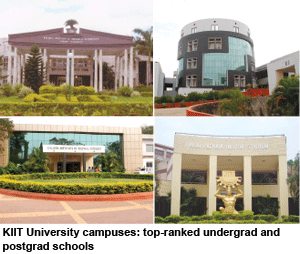 For most citizens of India, the eastern state of Odisha (formerly Orissa, pop. 41 million), off the grand trunk routes and air corridors which link the country’s premier cities, is unfamiliar territory. In the metropolitan press and media, it receives minimal coverage mostly to report either starvation deaths in its backward Kalahandi district and/or Maoist atrocities in the notoriously insurgent Kandhamal district. What’s less known is that this ancient state with a rich history and culture is the region where the great Mauryan Emperor Ashoka (304-232 BC) experienced a historic epiphany after waging the Kalinga war of 261 BC, which led him to embrace ahimsa (non-violence), one of the main tenets of Buddhism to which he converted after the war. Odisha is also famed for its magnificient 13th century Sun Temple at Konark, and the mighty Jagannath Temple (11th century) whose three main deities are hauled on a huge and elaborately decorated rath (chariot), and dragged through the seaside town of Puri by devotees in June-July every year.
For most citizens of India, the eastern state of Odisha (formerly Orissa, pop. 41 million), off the grand trunk routes and air corridors which link the country’s premier cities, is unfamiliar territory. In the metropolitan press and media, it receives minimal coverage mostly to report either starvation deaths in its backward Kalahandi district and/or Maoist atrocities in the notoriously insurgent Kandhamal district. What’s less known is that this ancient state with a rich history and culture is the region where the great Mauryan Emperor Ashoka (304-232 BC) experienced a historic epiphany after waging the Kalinga war of 261 BC, which led him to embrace ahimsa (non-violence), one of the main tenets of Buddhism to which he converted after the war. Odisha is also famed for its magnificient 13th century Sun Temple at Konark, and the mighty Jagannath Temple (11th century) whose three main deities are hauled on a huge and elaborately decorated rath (chariot), and dragged through the seaside town of Puri by devotees in June-July every year.
First-time visitors to Odisha (such as your correspondent) are likely to be pleasantly surprised by the smooth double carriageways and neat bung-alows of its green administrative capital Bhubaneswar (pop.1.9 million), and the quiet purpose with which its people tend to their business. Unheralded and unsung, the city has developed an impressive civic infrastructure, and latterly, has emerged as eastern India’s new academic centre with aspirations to replace Kolkata (Calcutta) whose once great colleges and universities were plunged into mediocrity and ruin by 34 years of uninterrupted rule of the leveling down Communist Party of India-Marxist (CPM), which mercifully ended last summer.
The official seal on the emergence of Bhubaneswar as a new hub of higher education, was conferred on this charming city when it was selected by the 22,000-strong Kolkata-based Indian Science Congress Association (ISCA, estb. 1914) to host its 99th Indian Science Congress (ISC) between January 3-7. With the focal theme of ‘Science & Technology for Inclusive Innovation — Role of Women’, the ISC was inaugurated by prime minister Dr. Manmohan Singh and attracted the world’s top women scientists and 18,000 delegates, who presented 1,500 research papers at the three-day conclave.
Whether any meaningful output commensurate with the time, money and effort invested emerged from the 99th ISC is doubtful, because Indian science continues to be characterised by shallow research and plagiarism, with little to show by way of new knowledge or inventions. However, the organis-ationally successful ISC served the useful purpose of showcasing the administrative capabilities and notable academic progress and development of KIIT University — initially promoted as the Kalinga Institute of Industrial Technology in 1992-93, and granted deemed university status by the University Grants Commission in 2004.
One of the country’s youngest private universities, within less than two decades it has promoted 23 aesth-etically architectured and landscaped schools of professional education delivering globally benchmarked under-graduate and postgrad education. The Kalinga Institute of Industrial Techn-ology — the engineering college of KIIT University — was ranked No. 16 all-India and No. 5 in eastern India by the Times of India-Gfk-Mode Survey, 2009 and among the Top 15 (IITs and NITs included) by the Dalal Street Journal (2010).
Since it introduced its first undergraduate study programme in 1997, KIIT has rapidly spawned schools of professional education — medical, dental, nursing, business management, law, fashion, rural management, bio-technology, film and media sciences, yoga and spiritualism, among others — which currently host 15,250 students mentored by 1,200 faculty and 2,300 support staff. These schools and students are housed in KIIT Univ-ersity’s 19 state-of-the-art campuses with an aggregate built-up area of 8 million sq. ft, scattered over 350 acres across Bhubaneswar.
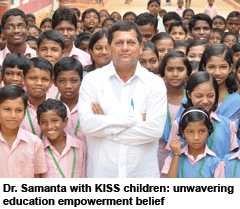 "Having experienced acute poverty and deprivation in my childhood and youth from which I was able to extricate myself through the power of education, it’s my life’s mission and purpose to eradicate the deep poverty and ignorance which is the natural condition of children and youth, especially among the tribal communities of Odisha and eastern India. Starting with capital of only Rs.5,000 and 12 students in 1992, and with the blessings of God and persistent effort, I have been able to build two great education institutions — KIIT University and the Kalinga Institute of Social Sciences (KISS). The latter provides wholly residential kindergarten to collegiate education to 15,000 children drawn from Odisha’s most backward tribal popu-lation, whose socio-economic condition is much worse than of the scheduled castes and tribes entitled to special affirmative action in the Constitution of India. I believe over the past two decades, we have been able to design a sound inter-connected education development model which will enable us to scale up our operations to make meaningful contributions towards poverty eradication through education on a mass scale,” says Dr. Achyuta Samanta, the visionary founder-director of KIIT University and KISS, and among the most admired and respected citizens of Odisha.
"Having experienced acute poverty and deprivation in my childhood and youth from which I was able to extricate myself through the power of education, it’s my life’s mission and purpose to eradicate the deep poverty and ignorance which is the natural condition of children and youth, especially among the tribal communities of Odisha and eastern India. Starting with capital of only Rs.5,000 and 12 students in 1992, and with the blessings of God and persistent effort, I have been able to build two great education institutions — KIIT University and the Kalinga Institute of Social Sciences (KISS). The latter provides wholly residential kindergarten to collegiate education to 15,000 children drawn from Odisha’s most backward tribal popu-lation, whose socio-economic condition is much worse than of the scheduled castes and tribes entitled to special affirmative action in the Constitution of India. I believe over the past two decades, we have been able to design a sound inter-connected education development model which will enable us to scale up our operations to make meaningful contributions towards poverty eradication through education on a mass scale,” says Dr. Achyuta Samanta, the visionary founder-director of KIIT University and KISS, and among the most admired and respected citizens of Odisha.
By any yardstick, the single-minded effort invested by Samanta in the promotion and development of KIIT and KISS and latterly in the KiiT International School (estb. 2007) is extraordinary and couldn’t have been achieved without divine intervention, which Samanta — a devout Hindu — readily acknow-ledges. Born in a remote village (Kalarabank) in Cuttack district as one of six children of a shopfloor employee in a steel plant, Samanta and his siblings experienced grinding poverty after their father died in a train accident in 1970. “It was quite routine in those difficult days for us to eat one square meal in two days, and my mother lacked a second saree to wear after bathing in the village river,” he recalls misty-eyed.
Nevertheless Samanta stayed the course in his village school and won a scholarship to SCS College, Puri in 1984, through which he supported himself by giving private tuitions. In 1987, by “self-studying 18 hours per day and subsisting on Rs.200 per month”, he earned a Masters in chemistry from Utkal University and landed a job as a lecturer in D.K. College, Jaleswar (1987-91) and later at the Maharishi College, Bhubaneswar when he promoted KISS on the side, in 1992.
Looking back on those difficult years, Samanta believes that besides divine intervention, it was his unwavering belief in the power of education to lift people out of poverty that enabled him to realise his KIIT-KISS dream even as he routinely suffered public ridicule and societal indifference. “Within less than 15 years KIIT has flowered into eastern India’s top institution of professional education, and KISS has evolved into the world’s largest school for aboriginal or tribal children,” he says with quiet satis-faction.
Dr. Samanta’s satisfaction with KIIT University’s evolution into one the country’s top ‘self-financed’ i.e private professional education varsities, is not unwarranted. Although a relatively young institution, it has attracted excellent lecturers and professors from across the country with 80 percent of faculty boasting Ph D qualifications. In 2010, the university staged an academic coup by recruiting Dr. Ashok Kolaskar, a pioneer of bioinformatics education worldwide and former vice chancellor of Pune University, where he established its first bioinformatics centre which he headed for two years, to accept the position of vice chancellor.
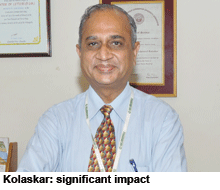 “I accepted the offer to head KIIT University because it is a wholly professionally-managed institution — Dr. Samanta is a bachelor who lives frugally and doesn’t have any family members involved with the varsity. And since all profits and surpluses are reinvested in institution building, we have been able to provide globally benchmarked infrastructure and attract excellent faculty by paying better than Sixth Pay Commission salaries and benefits. Moreover, since KIIT is a private university we have complete freedom to nurture and develop our faculty members by introducing innovations such as 360 degree faculty evaluation by students, peers and management,” says Kolaskar.
“I accepted the offer to head KIIT University because it is a wholly professionally-managed institution — Dr. Samanta is a bachelor who lives frugally and doesn’t have any family members involved with the varsity. And since all profits and surpluses are reinvested in institution building, we have been able to provide globally benchmarked infrastructure and attract excellent faculty by paying better than Sixth Pay Commission salaries and benefits. Moreover, since KIIT is a private university we have complete freedom to nurture and develop our faculty members by introducing innovations such as 360 degree faculty evaluation by students, peers and management,” says Kolaskar.
According to Kolaskar, this green university has already made a significant impact by way of academic initiatives in several areas such as developing software for testing and evaluating faculties of engineering colleges, and is an enthusiastic parti-cipant in IT major Wipro Corporation’s Mission 10x initiative to continuously train and upgrade engineering faculty in English language communication and student management. Besides, it is a member of the Indo-US committee on engineering education (2008) under which 6,000-7,000 engineering faculty have received supplementary education on the Mysore campus of Infosys Technologies Ltd.
“Moreover we have established a Centre of Excellence for SAP systems, a product life cycle management research initiative with the French company Dassault Corp, and encour-aged our faculty to submit 110 research papers to refereed journals in India and abroad. Within a short period of 15 years we have been successful in establishing KIIT as a truly national and globally benchmarked university,” says Kolaskar.
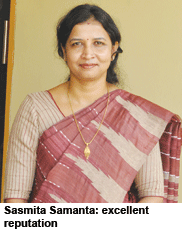 Consequently, given the manage-ment’s — and particularly Dr. Samanta’s commitment backed by funding, resources and operational autonomy — this university of professional education has won itself an excellent reputation in eastern India — if not quite in metropolitan India — and beyond national borders as well. “Seventy-five percent of our students are from beyond Odisha — mainly from the neighbouring states of eastern India and the north-east, SAARC countries, and some students from Turkey, Nigeria and China. Every year, over 150,000 students write our own joint entrance exam — KIIT-EE in 120 centres across India. Of them, only 3,500 who top the entrance exam are admitted. They are ready and willing to pay our tuition fees of Rs.1-5 lakh per year because of the excellent residential facilities — 12,000 of our 15,000 students reside on our 19 campuses — and the high quality education we provide through our excellent faculty,” says Dr. Sasmita Samanta (no relation), a business management alumna and registrar of KIIT University.
Consequently, given the manage-ment’s — and particularly Dr. Samanta’s commitment backed by funding, resources and operational autonomy — this university of professional education has won itself an excellent reputation in eastern India — if not quite in metropolitan India — and beyond national borders as well. “Seventy-five percent of our students are from beyond Odisha — mainly from the neighbouring states of eastern India and the north-east, SAARC countries, and some students from Turkey, Nigeria and China. Every year, over 150,000 students write our own joint entrance exam — KIIT-EE in 120 centres across India. Of them, only 3,500 who top the entrance exam are admitted. They are ready and willing to pay our tuition fees of Rs.1-5 lakh per year because of the excellent residential facilities — 12,000 of our 15,000 students reside on our 19 campuses — and the high quality education we provide through our excellent faculty,” says Dr. Sasmita Samanta (no relation), a business management alumna and registrar of KIIT University.
But although by continuously raising and investing resources — KIIT University has an aggregate liability of Rs.400 crore to several banks — Dr. Samanta has vaulted this hitherto low-profile varsity into most Top 50 universities league tables, under an ingenious schema devised by him, KIIT University is a means to a greater end: to fund and grow KISS, the school/college promoted in 1992 which currently offers 15,000 children and youth from 62 tribes — including 13 most primitive tribes — kindergarten to postgraduate fully- residential education on its 60-acre campus in Bhubaneswar.
Under the schema, 3 percent of the aggregate revenue of KIIT University (a sum amounting to Rs.6 crore); 3 percent of the gross salary of its faculty and staff members (Rs.3 crore); 2-3 percent of the gross profits of vendors and suppliers (Rs.2 crore); donations from parents, students and well-wishers (Rs.4 crore) are funneled into KISS to develop the latent and utterly neglected capabilities of the institute’s 15,000 tribal children and youth. This substantial sum is supplemented by an annual grant (effective from the academic year 2011-12) of Rs.4.75 crore from the Union government’s ministry of social justice and tribal welfare towards the nutritional needs of 5,000 students, and corporate donations and proceeds of sale of handicrafts and other products made by students in their vocational classes (30 percent of the revenue is retained by KISS with students sending the rest to their impoverished familes back home).
 “The Rs.25 crore that we raise annually from this funding model is sufficient to provide fully residential education to 11,000 K-10 children; 800 in higher secondary school and 3,000 students in higher education at an average expenditure of Rs.25,000 per student per year. While we follow the syllabus of the Odisha state examination board, English is taught from class III onwards and we have integrated a comprehensive life skills and vocational training — including an ‘earn-and-learn’ programme which enables children to contribute to the finances of their parents and siblings back home — into the KISS curriculum. Our education model has sparked the imagination of the 11 million tribal population of Odisha, because we receive over 40,000 admission appli-cations annually against which unfortunately, we are able to admit only 1,000-2,000 children,” says Dr. Prashanta Routray, who has a Ph D in child education from Utkal University and served in several NGOs before signing up as chief executive of KISS in 2005.
“The Rs.25 crore that we raise annually from this funding model is sufficient to provide fully residential education to 11,000 K-10 children; 800 in higher secondary school and 3,000 students in higher education at an average expenditure of Rs.25,000 per student per year. While we follow the syllabus of the Odisha state examination board, English is taught from class III onwards and we have integrated a comprehensive life skills and vocational training — including an ‘earn-and-learn’ programme which enables children to contribute to the finances of their parents and siblings back home — into the KISS curriculum. Our education model has sparked the imagination of the 11 million tribal population of Odisha, because we receive over 40,000 admission appli-cations annually against which unfortunately, we are able to admit only 1,000-2,000 children,” says Dr. Prashanta Routray, who has a Ph D in child education from Utkal University and served in several NGOs before signing up as chief executive of KISS in 2005.
Management of this unique instit-ution — reportedly the world’s largest boarding school — providing K-XII and undergraduate education to 15,000, mainly first generation students speaking 30 tribal languages for whom even Oriya is unfamiliar, is a gargantuan task. With a built-up area of 600,000 sq. ft, KISS is equipped with a 50 kw solar power plant, an RO water filtration plant which supplies 100,000 litres of potable water daily, and a fully mechanised kitchen which serves 45,000 meals per day in a dining hall with a seating capacity of 10,000. It has 15,000 students residing in 10 dormitories equipped with 11,000 two-tier and three-tier beds, and utilising 800 shower-bathrooms and 800 toilets, amenities wholly unfamiliar to tribal children.
The academic infrastructure includes 105 classrooms (operating in two shifts), two computer labs to seat 600 students, a 15,000 sq. ft library equipped with 150,000 books and e-journal subscriptions, a wi-fi system-enabled campus and close circuit television camera system for children’s safety and security. But this huge management challenge seems par for the course for Pramod Kumar Patra, an education and law graduate of Utkal University who signed up with KISS in 1998 as an Oriya literature teacher and is currently headmaster of the K-10 school, which has 11,000 students on its muster roll. Instead, he prefers to highlight the academic achievements of KISS’ secondary students.
 “Although most of our children are first generation learners, all 535 students who wrote the Odisha Board of Secondary Education class X exam last year, passed against the statewide average of 70 percent, and 40 percent were placed in the first division. We also ensure that all child-ren receive parallel vocational training with earn-and-learn opportunities, and that they have access to a wide variety of indoor and outdoor games and sports facilities. Indeed, many of our students have won national and international awards in archery, hockey, rugby and kho-kho,” says Patra, who rates KISS as India’s best tribal school and among the Top 5 state board-affiliated secon-daries in Odisha.
“Although most of our children are first generation learners, all 535 students who wrote the Odisha Board of Secondary Education class X exam last year, passed against the statewide average of 70 percent, and 40 percent were placed in the first division. We also ensure that all child-ren receive parallel vocational training with earn-and-learn opportunities, and that they have access to a wide variety of indoor and outdoor games and sports facilities. Indeed, many of our students have won national and international awards in archery, hockey, rugby and kho-kho,” says Patra, who rates KISS as India’s best tribal school and among the Top 5 state board-affiliated secon-daries in Odisha.
Dr. Arjun Sahoo, hitherto professor of zoology at Bhubaneswar’s SVM Autonomous College affiliated with Utkal University, and currently principal of the Plus Two and collegiate programmes at KISS, is equally satisfied with the unique academic-cum-voca-tional education provided to the institute’s senior students. “Apart from higher secondary, we provide under-graduate and postgraduate arts, science and commerce education combined with vocational programmes to 2,100 students. Given the strong emphasis on skills development for KISS children right from primary school, we ensure all our graduates are workplace-ready and secure employment. Our brightest and most gifted students are given special training and admitted into an appro-priate school of KIIT University, which has a 5 percent full scholarship reserved quota for KISS graduates, translating into a Rs.20 crore loss of revenue for the university annually. But this reserved quota for tribal students has paid off in a big way because many of our students graduating from KIIT University have been placed in top corporates such as TCS, Infosys, Wipro and Accenture, until recently an impossible achievement for first generation tribal students,” says Sahoo.
Dr. Samanta’s empathy with the cruelly neglected and persecuted (by timber and mining mafias and complicit government officials) tribal population of Odisha is indicated by the strong focus and considerable investment in developing co-curricular (dance, music, drama, yoga) and extra-curricular games and sports facilities on the KISS campus. The sprawling campus boasts five large grounds for field games such as hockey, football, rugby, volleyball, softball; indigenous games such as kho-kho and kabbadi; athletics tracks and an archery range — games and sports in which tribal sportspersons traditionally excel.
Although it’s rare to encounter tall children or youth in KISS (the conse-quence of child malnutrition which is commonplace in the tribal areas of the state), KISS students have done the institute proud. Among their more noteworthy achievements: the school’s team won the International Under-13 Rugby Championship held in London in June 2011; the K-10 school team was the finalist in the Schools National Football Tournament held in Jammu in September 2011; several girl students have donned India rugby colours; and others have represented the state and national teams in kho-kho, kabbadi, weightlifting, hockey and archery.
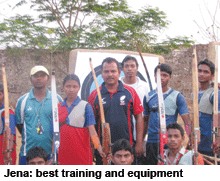 Comments Rudrakesh Jena, an arts and physical education graduate of Utkal University and additional sports officer, who heads a batch of 16 trained sports educators in KISS: “Sports education, on which we spend Rs. 2.5 crore annually, is an integral part of the curriculum and there’s no compromise on providing our students with the best training and equipment. And our boys and girls have distinguished them-selves in many games and sports. In rugby, KISS has established an international reputation by winning the Under-14 World Championship in London in 2007 and the Under-13 championship in Manchester in 2011. Interestingly, one of our girls played women’s rugby for India in the Asian Games in China last year and two of our archers won gold medals in the National School Games. Our hockey, kho-kho, kabaddi and volleyball teams are among the best in Odisha,” says Jena.
Comments Rudrakesh Jena, an arts and physical education graduate of Utkal University and additional sports officer, who heads a batch of 16 trained sports educators in KISS: “Sports education, on which we spend Rs. 2.5 crore annually, is an integral part of the curriculum and there’s no compromise on providing our students with the best training and equipment. And our boys and girls have distinguished them-selves in many games and sports. In rugby, KISS has established an international reputation by winning the Under-14 World Championship in London in 2007 and the Under-13 championship in Manchester in 2011. Interestingly, one of our girls played women’s rugby for India in the Asian Games in China last year and two of our archers won gold medals in the National School Games. Our hockey, kho-kho, kabaddi and volleyball teams are among the best in Odisha,” says Jena.
The extraordinary success of KISS in providing holistic K-postgrad education to children of India’s exploited hunter-gatherer aboriginal population has not gone unnoticed. A perennial stream of visiting eminences flows through the KISS campus every year with most of them expressing amazement and astonishment at the achievements of KISS (see box). Several United Nations agencies, foreign universities and corporates have also been sufficiently moved to lend aid and advice to the institute’s management. For instance, UNFPA (United Nations Population Fund) runs a life skills and sexual health counseling programme on the KISS campus; Unicef and KIIT University have jointly established a Centre for Child Studies; Unesco has initiated a ground water study and management programme; the US Embassy has spon-sored an English language learning programme for 14-16 year-olds; and Hanseo University, South Korea runs a mentorship programme for 100 students and supports the girls rugby team.
But while over the past 20 years KISS has won great plaudits as a model institution for educating and main-streaming the country’s aboriginal people, given that their population countrywide is estimated at 85 million with 11 million in Odisha itself, quite clearly the KISS model needs to be replicated and rolled out nationally. This social need and imperative has prompted Samanta and his top management team to draw up plans to promote 20 new KISS schools in eastern India. And for this purpose, the KIIT Society has recently established a task force with cells in Delhi and the metros to raise funding from corporates and philan-thropists.
“Given the self-evident success of KISS which has prompted several UN agencies and embassies to support us, corporate India is stepping forward to help tribal children, many of whom have been displaced by industrial projects in mineral-rich tribal areas. For instance, Tata Steel has funded a Rs.3.5 crore Tata Memorial Library in KISS which will be completed and operationalised this year. Moreover, with KISS assistance, the public sector National Mineral Development Corporation has fully-funded a Rs.100-crore grant to NMDC-KISS Residential Public School in the Bastar district of neighbouring Chhatti-sgarh, which will admit its first batch of 200 students in July. This single source- financed school will provide corporate India a perfect CSR (corporate social responsibility) school education model. I am sure many corporates in Odisha and beyond will be inspired by this new school,” says Dviti Vikramaditya, a political science graduate of Delhi University who served a long stint with UNDP, and is a Unicef consultant advising Dr. Samanta and KISS on how to establish fundraising cells.
Against this backdrop of both KIIT University and KISS having steadily established themselves as highly-respected institutions of education with wide outreach and social purpose, Dr. Samanta has set his sights higher and wider. “KIIT University has reached its optimal expansion capability and now our focus within the university will be on continuously improving the quality of teaching, academics and research. Therefore, all our expansion and outreach efforts will be concentrated in KISS. We have drawn up plans to promote KISS institutions in eight tribal areas of Odisha and other eastern India states. And with our credentials firmly established, I am confident we will be able to raise funding from the Central and state governments and from Indian industry, to establish KISS model schools for scheduled castes and tribal children countrywide. Meaningfully educating and mainstreaming children from bottom-of-the-pyramid families is the best prescription for combating the threat of Naxalism, and raising the poor majority out of poverty,” says Samanta.
That’s a prescription difficult — indeed impossible — to contradict.